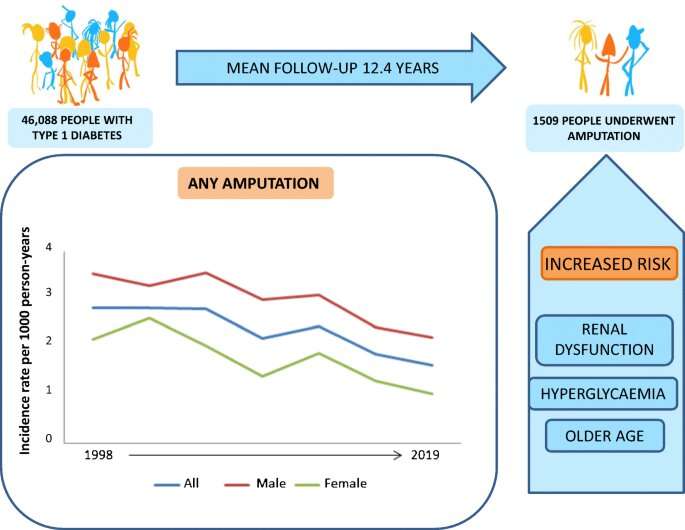Sharp fall in amputations due to type 1 diabetes


Amputation in type 1 diabetes is becoming relatively less common in Sweden. The rate has fallen by just over 40 percent over an approximately 20-year period, a University of Gothenburg study shows.
The results, published in the journal Diabetologia, are based on registry data on 46,088 people with type 1 diabetes in the years 1998–2019. The study involved linking data from the Swedish National Diabetes Register, the National Patient Register and a couple of other Swedish national registers.
The researchers studied how the incidence of amputations changed over time, and also conducted a survey of risk factors for amputation in people with type 1 diabetes.
The average age of the patients covered by the data when they were included in the study was 32 years. At the time, none of them had undergone amputations. Fifty-five percent were men and 45 percent women.
Trend reversal for the better
Initially, in the years 1998–2001, the probability of amputation was 2.84 per 1,000 people on an annual basis. In the last few years of the study, 2017–2019, the corresponding figure was 1.64/1,000. The proportion of people undergoing amputation annually thus fell by 42 percent.
The study’s first author is Sara Hallström, a doctoral student in molecular and clinical medicine at Sahlgrenska Academy, University of Gothenburg, and specialist doctor in internal medicine at Sahlgrenska University Hospital.
“We see a trend reversal in the period from 2014 to 2016, and a couple of years before that there were evidently declining long-term blood sugar levels and improving kidney function. These are the risk factors that, in the study, proved to be the major ones for amputation in people with type 1 diabetes,” Hallström says.
Other risk factors identified were advanced age, male sex, cardiovascular disease, smoking, and high blood pressure.
More care, less suffering
In the researchers’ view, the improvement in prognosis is probably due to development of diabetes care in recent years. Intensive treatment of risk factors subject to influence using, for example, continuous blood-glucose measurement and advanced insulin pumps, is now underway. Multidisciplinary diabetes foot teams have also been introduced.
The team helps patients with foot wounds that do not heal readily, owing to the vascular changes and impairment in sensation that diabetes can cause. Eventually, nonhealing wounds may necessitate amputations of the foot, and in more severe cases also of the lower legs and thighs.
Source: Read Full Article